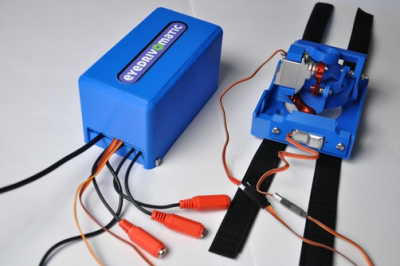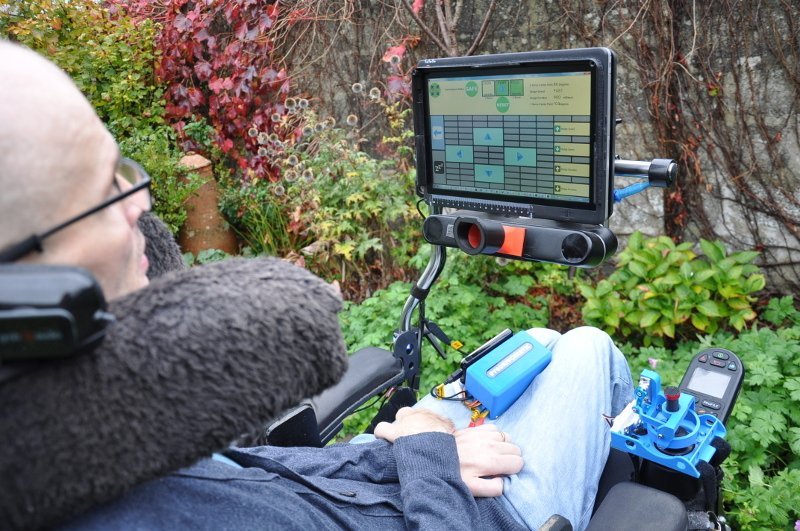For this year’s Hackaday Prize, we opened up five challenges for hackers and tinkerers to create the greatest hardware in five categories. We asked citizen scientists to build something to expand the frontiers of knowledge. We asked automation experts to build something more useful than the Internet of chocolate chip cookies. In the Assistive Technologies portion of the prize, we asked our community of engineers to build something that would open the world up to all of us.
While this year’s Assistive Technologies challenge brought out some great projects, there is one project from last year that must be mentioned. The Eyedrivomatic is a project to turn any electric wheelchair into a gaze-controlled robotic wheelchair, opening up the world to a population who has never had this level of accessibility at a price this low.
 The Eyedrivomatac was the winner of last year’s Hackaday Prize, and given the scope of the project, it’s not hard to see why. The Eyedriveomatic is the solution to the problem of mobility for quadriplegics. It does this surprisingly simply by adding a servo-powered robot onto the joystick of an electric wheelchair, with everything controlled by eye gaze technology. While other systems similar to this exist, it’s the cost of the Eyedrivomatic system that makes it special. The robotic half of the project can be easily manufactured on any 3D printer, all the associated hardware can be bought for just a few dollars, and the software stack is completely open source. The entire system is interchangeable between different models of electric wheelchairs without any modifications, too.
The Eyedrivomatac was the winner of last year’s Hackaday Prize, and given the scope of the project, it’s not hard to see why. The Eyedriveomatic is the solution to the problem of mobility for quadriplegics. It does this surprisingly simply by adding a servo-powered robot onto the joystick of an electric wheelchair, with everything controlled by eye gaze technology. While other systems similar to this exist, it’s the cost of the Eyedrivomatic system that makes it special. The robotic half of the project can be easily manufactured on any 3D printer, all the associated hardware can be bought for just a few dollars, and the software stack is completely open source. The entire system is interchangeable between different models of electric wheelchairs without any modifications, too.
Since winning last year’s Hackaday Prize, Patrick, Steve, and David of the Eyedrivomatic project received the grand prize of $196,883, and are now working towards starting their own production run of their revolutionary device. Right now, there’s a small cottage industry of eye gaze controlled wheelchairs cropping up, and the Eyedrivomatic team is busy building and assembling systems for electric wheelchair users across the globe.
The Eyedrivomatic is the best the Hackaday Prize has to offer. At its heart, it’s an extremely simple device — just a few 3D printed parts, a few servos, an Arduino, and some open source software. The impact the Eyedrivomatic has on its users can’t be understated. It is a liberating technology, one of the greatest projects we’ve seen, and we’ve very proud to have the Eyedrivomatic as a Hackaday Prize champion.




















He’s supposed to watch in front of himself, not at a screen while moving. This looks like an accident waiting to happen.
Right! He could end up in a, oh, never mind.
Even though he is looking at a screen that does not imply that he is distracted by it, with some training you can focus on your peripheral vision with no problem. I suspect that if you’re heavily restricted in your mobility you use your peripheral vision quite a lot more than most people and as such are also much more proficient at it.
That in combination with the adjustable speed settings to account for different environments I’m going to go out on a whim and say you are being over concerned.
It’s a fair point. Since Patrick built the original software, I’ve jumped in to take that task. I’m currently working on a version with a forward looking camera.
It can’t be that hard to do some of that ‘augmented’ stuff and have an image of what is in front of the guy so he knows not to crash into it.
Probably the only real crash risk would be e.g. an unattended baby, normal human would have to be pretty ignorant to get in the way of a wheelchair so possibly cyclists.
sure its great to say that its cheap as chips and a tenth of the price of commercial stuff but of course that is the case because if a wheelchair company made 3d printed plastic parts on a homemade printer and didn’t factor any r&d or development into the cost then they would probably bankrupt themselves even before any regulating body managed to get to them.
The safety bypass looks fun!
Based on the icon, it looks like the safety bypass was sponsored by Hackaday.
I’m a rehab engineer and honestly, no one would do this. The device itself is a visual impairment and even if is could be
reduced to a compact tracker, the way you actually use your eyes to watch a scene makes this type of control a hazard.
You’d have to do a lot of stopping to evaluate the scene, then move, stop and re-eval…….etc. Eye tracking is useful if you have no other means, but I would not even conside it for driving given the liability.
I can’t say I’m surprised by the rehab engineer’s response as my experience of rehab personnel and occupational therapists is health and safety concerns feature so high above anything else that the people they’re supposed to be helping are shackled with largely inappropriate aids because the most suitable option carried a tiny element of risk! As one of the Eyedrivomatic team and a user of the device, I have always ensured users know the risks and this extract is from the website
“No eyegaze system will work in direct sunlight and some even struggle in bright daylight without sun so I think realistically Eyedrivomatic should be seen as an assistant to assistant / carer control as opposed to a replacement! And similarly when it comes to hazardous environments, I wouldn’t feel comfortable using any eye controlled device when the consequences of an inadvertent steering input puts the wheelchair over a kerb tipping it over in the process.
Saying all that, I still use Eyedrivomatic every day and even with these limitations I would be lost without it. I drive around the house and outside will drive short distances. Even just the ability to turn to change your view or see something of interest is immensely liberating after years of being dependent on others. Also it’s great being able to recline the chair yourself as it enables me to lift my head to relieve neck pain. In fact one user got Eyedrivomatic just to do that! ”
I credit users with enough common sense to use the system only in safe environments and if that’s done, I can assure you this is a phenomenally liberating device
I can’t say I’m surprised by the rehab engineer’s response as my experience of rehab personnel and occupational therapists is health and safety concerns feature so high above anything else that the people they’re supposed to be helping are shackled with largely inappropriate aids because the most suitable option carried a tiny element of risk! As one of the Eyedrivomatic team and a user of the device, I have always ensured users know the risks and this extract is from the website
“No eyegaze system will work in direct sunlight and some even struggle in bright daylight without sun so I think realistically Eyedrivomatic should be seen as an addition to assistant / carer control as opposed to a replacement! And similarly when it comes to hazardous environments, I wouldn’t feel comfortable using any eye controlled device when the consequences of an inadvertent steering input puts the wheelchair over a kerb tipping it over in the process.
Saying all that, I still use Eyedrivomatic every day and even with these limitations I would be lost without it. I drive around the house and outside will drive short distances. Even just the ability to turn to change your view or see something of interest is immensely liberating after years of being dependent on others. Also it’s great being able to recline the chair yourself as it enables me to lift my head to relieve neck pain. In fact one user got Eyedrivomatic just to do that! ”
I credit users with enough common sense to use the system only in safe environments and if that’s done, I can assure you this is a phenomenally liberating device
And as for your “no one would do this ” then how do you explain the fact that we’ve already supplied TWENTY systems